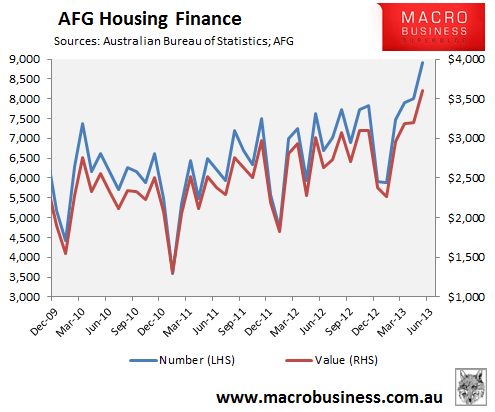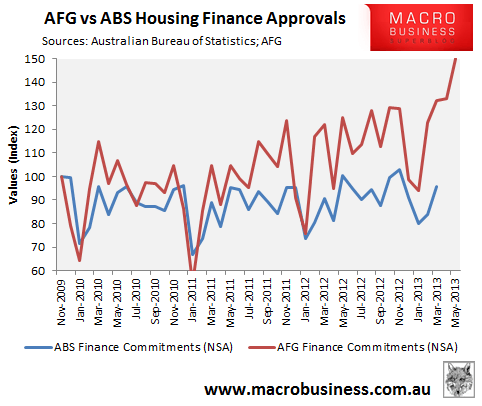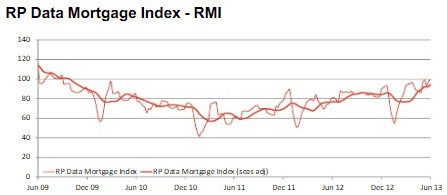
Australian Finance Group (AFG) yesterday released its housing finance data for the month of May, which registered the Group’s strongest monthly mortgage applications on record, with 8,921 mortgage applications (valued at $3,608 million) processed over the month, an improvement of 16.8% on May 2012 (see next chart).

According to the media release:
Demand for mortgages rose most strongly in WA, where mortgages processed increased by 17.7% over April, followed by Victoria (+14.6%), NSW (+10.9%), SA (+8.6%) and QLD (+7.2%).
Demand rose consistently across all buyer types – first home buyers, investors and borrowers looking to refinance. But compared to May 2012, there was a larger share of upgraders, who comprised 15.9% of all mortgage sales last month compared to 11.3% in May 2012.
Mark Hewitt, General Manager of Sales and Operations says: ‘We’ve seen a marked increase in borrowing activity since February. Borrowers of all types were encouraged by the further rate reduction in early May and the expectation that we’re in a low rate environment for some time to come. Reassuringly, the recent growth looks sustainable and we are not seeing the normal characteristics of a boom. The average new loan size is the same as it was over a year ago, LVRs are consistent, and in New South Wales and Queensland, first home buying activity is running at about a third of the long term average.’
AFG continued to report huge variances in first home buyer (FHB) mortgage share in May, with FHB demand remaining weak in New South Wales and Queensland, but booming in Western Australia:
- National: 13.6%
- New South Wales: 4.3%
- Victoria: 18.9%
- Queensland: 5.9%
- Western Australia: 24.4%
- South Australia: 14.9%
We might expect FHB applications to pick-up this month in Victoria prior to the 1 July expiry of the FHB Grant on pre-existing homes, after which it’s a fair bet they will collapse like in the other eastern states.
As noted last time, some caution should be exercised in interpreting AFG’s figures and extrapolating its results to the overall mortgage market, as measured by the Australian Bureau of Statistics (ABS).
AFG’s data measures mortgage applications, whereas the ABS measures actual mortgage commitments. According to AFG’s General Manager of Sales & Operations, Mark Hewitt, just over three quarters of applications on average become mortgage commitments, although this figure can obviously fluctuate month-to-month. AFG’s market share has also been rising in recent years.
Therefore, while AFG is a useful guide as to the strength of mortgage demand, its results do not necessarily translate to the overall mortgage market as captured later by the ABS.
To illustrate, consider the below chart showing how the growth of AFG mortgage applications has diverged significantly from ABS mortgage commitments since November 2009:

That said, RP Data’s Mortgage Index, which is supposed to provide a leading indicator of housing finance commitments, showed a seasonally adjusted lift in May, lending weight to the idea that the ABS will show a another decent lift in finance commitments when it reports its May results next month (see next chart).


